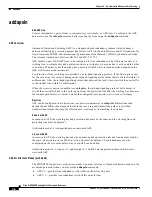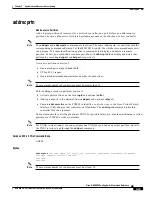
3-8
Cisco MGX 8850 Routing Switch Command Reference
Release 2.0, Part Number 78-10467-04 Rev C0, October 2001
Chapter 3
Equipment and Resource Provisioning
addcontroller
addcontroller
Add Controller
Identifies a network control protocol to the Virtual Switch Interface (VSI) that runs on the node. If you
do not identify a network control protocol (or simply controller), the switch does not use it. Adding a
controller through the addcontroller command requires the following information:
•
The type of controller, such as PNNI
•
Where the controller runs—internally, on the local PXM45, or externally, through a virtual
connection
Note
Currently, the only supported controller is PNNI, and it runs only as an internal controller.
Use addcontroller before you create resource partitions the service modules. For information on
resource partitions, see the description of addpart (or addrscprtn).
If you discover an error in your controller specification after you add it, delete the controller by
executing delcontroller then add it again.
Cards on Which This Command Runs
PXM45
Syntax
The syntax differs for internal and external controllers:
Internal controller:
addcontroller <cntrlrId> i <cntrlrType> <lslot> cntrlrName]
External controller:
addcontroller <cntrlrId> x<cntrlrType> <lslot> <bay> <line> <vpi> <vci> [cntrlrName]
Syntax Description for Internal Controller
cntrlrId
A number in the range 1–3 that identifies a network controller. The numbers are
reserved, as follows:
1 = PAR (Portable AutoRoute)—currently not used
2 = PNNI
3 = LSC (Label Switch Controller, also known as MPLS for Multiprotocol Label
Switch Controller)—currently not used
Note
For an internal controller, the controller ID (cntrlrId) must be the same as
the controller type (cntrlrType). Currently, the only available controller is
PNNI, and only internal controllers are supported. Therefore, the only
valid argument string for addcontroller is “2 i 2.” See the example.
i
Keyword indicating that this controller is internal.
















































